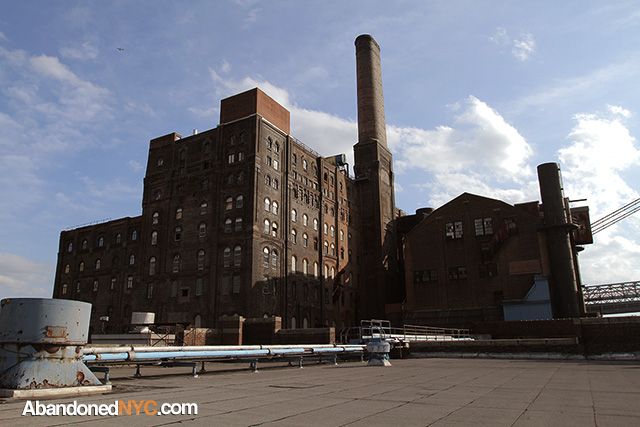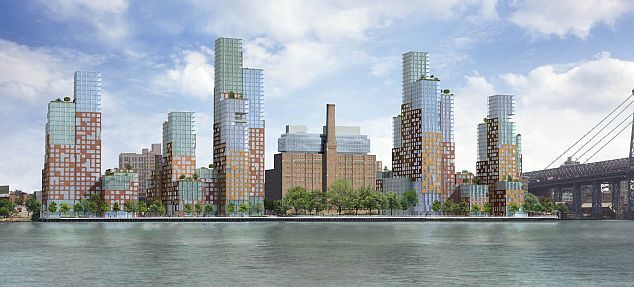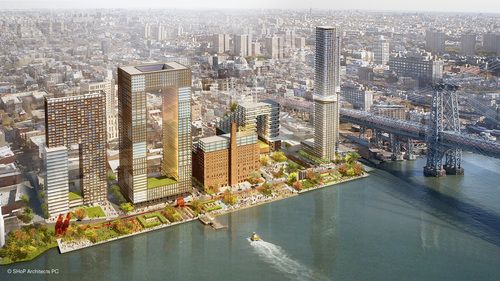How to See the Liberty Bell...in Queens
A copy of the famous American bell can be found inside a bank, which itself is modeled after Independence Hall!

In the late 19th century, Brooklyn was responsible for over half of the country’s sugar production, with Havemeyers & Elders Sugar Company leading the pack of over 20 major refineries that called the borough home. The factory’s signature building—a towering redbrick structure that still stands today—was constructed in 1884 to replace an older sugarhouse that had been destroyed in a catastrophic fire. Three years later, 17 of the largest sugar refiners in the U.S. merged to form the Sugar Refineries Co. Trust, later reorganized as the American Sugar Refining Co., and branded as Domino Sugar in 1902. Domino and its predecessors operated on the waterfront for a total of 148 years; at its peak, the Domino Sugar Refinery site employed over 5,000 workers, capable of producing over three million pounds of processed sugar a day.

The growing use of high fructose corn syrup and artificial sweeteners caused a decline in demand for old-fashioned cane sugar. Production at the Williamsburg plant ended in the early 2000s with partial packaging operations lingering until 2004. The non-profit Community Preservation Corporation purchased the Domino Sugar Refinery site the same year for $58 million. Their plan would preserve and renovate the central refinery building, landmarked in 2007, and raise a battalion of residential high-rises in the footprint of the surrounding industrial complex, razing the Raw Sugar Warehouse, constructed in 1927, and the Packaging House, a 1962 addition, in the process.

At the time of the purchase, the organization had strayed far from its mission of providing housing to low income families. Through an atypical for-profit arm, luxury developments accounted for half of its capital use in recent years, leading the Community Preservation Corporation (CPC) into riskier ventures. After years of planning and litigation, having won a hard-fought rezoning battle, the CPC ran into dire financial straits, and the universally maligned plans fell through. Last year, the site was offered up for sale, and found a buyer in Two Trees, the group largely responsible for the redevelopment of DUMBO.
Two Trees teamed up with noted NYC firm SHoP Architects—the Columbia architecture-trained architectural firm has already left a lasting impression on the city landscape with the Barclays Center and the East River Esplanade. Unveiled Friday, their monumental plans seem tailor-made to appease the new population of Williamsburg, without limiting profits.

The plan is similar in scope to the vision of the CPC, with several key improvements. The buildings rise higher—up to 60 stories—to allow for more park space, including a one-acre “Domino Square,” where builders envision film screenings and outdoor concerts. Some of the structures include open spaces and sky bridges, an innovative solution sought to preserve harbor views for the inland community. The landmarked refinery building would be preserved and converted to office space, and several pieces of machinery would be salvaged for inclusion in a public “artifact walk.” In the face of such monumental changes, this may be of some consolation to New York nostalgics.
Developers are working with the YMCA to establish a community space on the site, and are also proposing a new public school. Street level retail would favor independent business over chain store tenants. Two Trees also intends to deliver on the previous developer’s promise of 660 units of “affordable” housing, though the condition was never legally binding.
With all these benefits, Two Trees is attempting to pacify a community that is weary of change, and concerned for its future. The Domino Sugar Refinery development marks a clear and dramatic manifestation of a contentious transition that’s been taking place in Williamsburg for the last decade. The area is well known today as a haven for hipster youth, but 10 years ago the neighborhood was a quiet, working-class community of immigrants. Perhaps it won’t be long before the tattooed and the trendy are priced out. Emerging across formerly affordable areas of Manhattan and Brooklyn, the familiar pattern is destined to change the face of our city. Call it progress or gentrification. Praise the plans, or lament the loss, the redevelopment of New York City continues.
See more photos of the Domino Sugar Refinery and other New York City abandonments on AbandonedNYC.com, and check out the Abandoned NYC Facebook page.
Subscribe to our newsletter